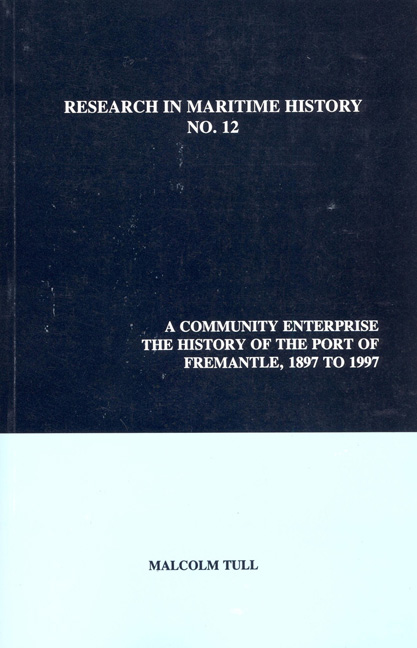Book contents
- Frontmatter
- Table of Contents
- List of Tables
- List of Figures
- List of Photos
- Acknowledgements
- Abbreviations
- Conversions
- Introduction
- Chapter 1 The Birth of A Modern Port
- Chapter 2 The Establishment of The Fremantle Harbour Trust
- Chapter 3 The Development Of Trade At The Port of Fremantle
- Chapter 4 The Shipping of Fremantle
- Chapter 5 A Century of Port Development, 1897 To 1997
- Chapter 6 Cargo-Handling Technology, Working Conditions And Industrial Relations on The Fremantle Waterfront
- Chapter 7 From Port Authority To Strategic Manager: The Transformation of The FPA
- Appendix A Trade and Shipping Statistics
- Appendix B Financial Statistics
- Appendix C Labour Statistics
- Appendix D
- Bibliography
- Index
Appendix A - Trade and Shipping Statistics
- Frontmatter
- Table of Contents
- List of Tables
- List of Figures
- List of Photos
- Acknowledgements
- Abbreviations
- Conversions
- Introduction
- Chapter 1 The Birth of A Modern Port
- Chapter 2 The Establishment of The Fremantle Harbour Trust
- Chapter 3 The Development Of Trade At The Port of Fremantle
- Chapter 4 The Shipping of Fremantle
- Chapter 5 A Century of Port Development, 1897 To 1997
- Chapter 6 Cargo-Handling Technology, Working Conditions And Industrial Relations on The Fremantle Waterfront
- Chapter 7 From Port Authority To Strategic Manager: The Transformation of The FPA
- Appendix A Trade and Shipping Statistics
- Appendix B Financial Statistics
- Appendix C Labour Statistics
- Appendix D
- Bibliography
- Index
Summary
This appendix presents trade and shipping statistics for Fremantle between 1903-1904 and 1995-1996.
Trade Statistics
The financial year 1903-1904 was chosen as a starting date because this is the first fall financial year for which port trade data are available. For most of the period covered by this book, Fremantle, in common with other Australian ports, measured cargo in revenue tonnes. This was a combination of measurement cargo at one cubic metre = one tonne (formerly 40 cubic feet = 1 ton) and weight or mass tonnes (formerly 2240 lbs. = 1 ton). The ports assessed cargo on the deadweight or measurement basis, depending on which yielded the greatest revenue.
In 1977, in order to increase uniformity between ports, the Council of the Australian Port Authorities Association decided that port statistics should be published in mass tonnes with the optional inclusion of revenue tonnes. The FPA commenced the collection of statistical data on both a revenue and mass basis from 1 July 1978. From the 1979-1980 financial year all data have been presented in terms of mass tonnes. In the FPA's Annual Report for 1979-1980 it stated that mass imports into and exports out of Fremantle approximated eighty-three percent and ninetythree percent, respectively, of their equivalent revenue tonnage. Thus while these data are not directly comparable to the years prior to 1979- 1980, the effect is to only slightly reduce the measured level of port trade.
Strictly speaking, the resulting aggregate series of cargo tonnages are not meaningful for analysis because the unit of measurement is not constant. To establish a constant unit revenue tonnes calculated on a measurement basis must be converted to a deadweight basis or vice-versa. In practice this is impossible due to data limitations and it is necessary to use the combined weight/volume measure. In order to facilitate comparisons data have been converted from tons to tonnes on the basis that 1 ton = 1.02 tonnes.
Shipping Statistics
There are three main measures of merchant shipping tonnage: gross registered tonnage (grt), net registered tonnage (nrt) and deadweight tonnage (dwt). Gross registered tonnage is based on the total volume of enclosed ship space. Net registered tonnage is based on the total volume of enclosed ship space which can be utilised for passengers or cargo (1 ton = 100 cubic feet).
- Type
- Chapter
- Information
- A Community EnterpriseThe History of the Port of Fremantle, 1897 to 1997, pp. 279 - 290Publisher: Liverpool University PressPrint publication year: 1997



